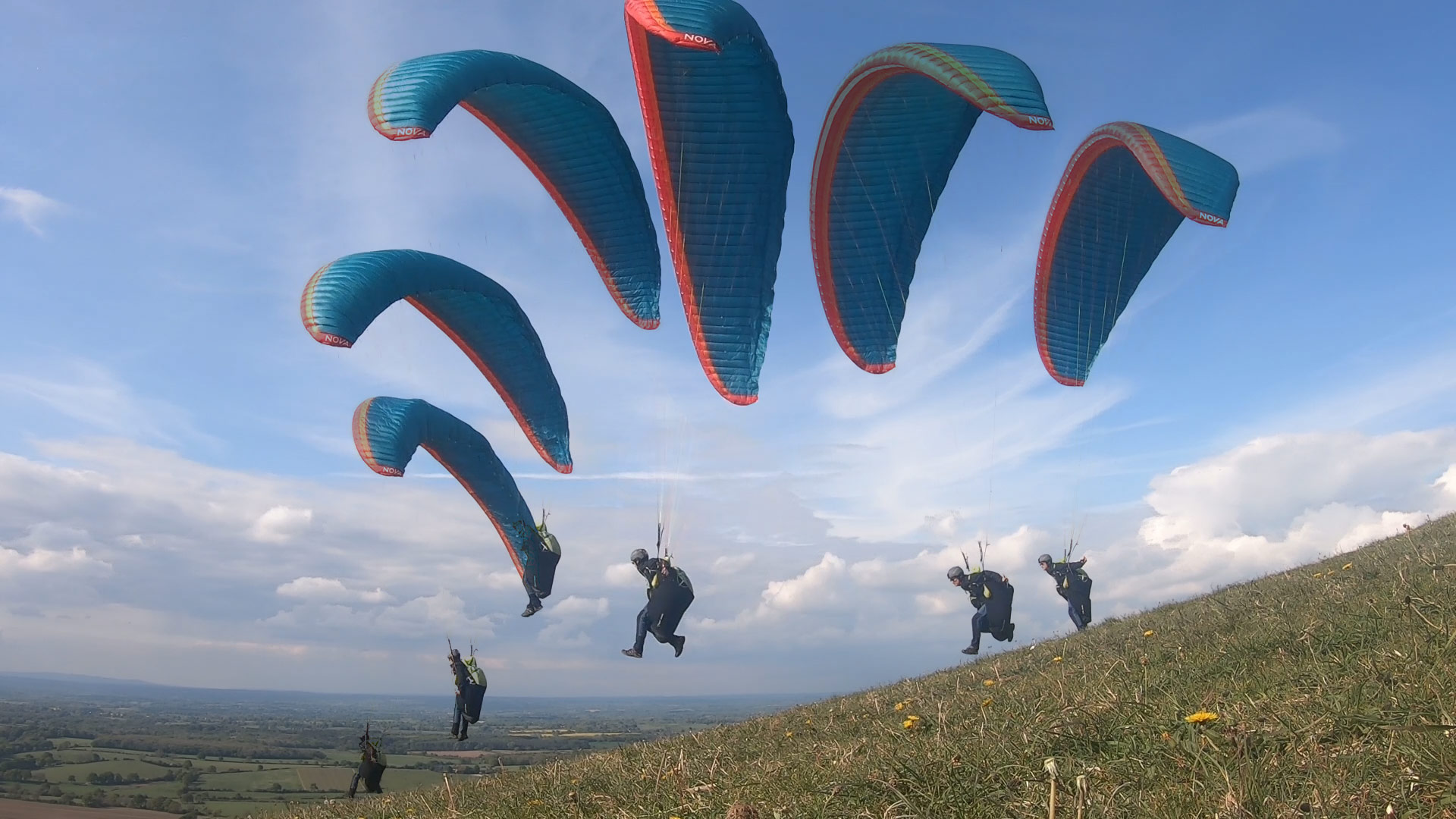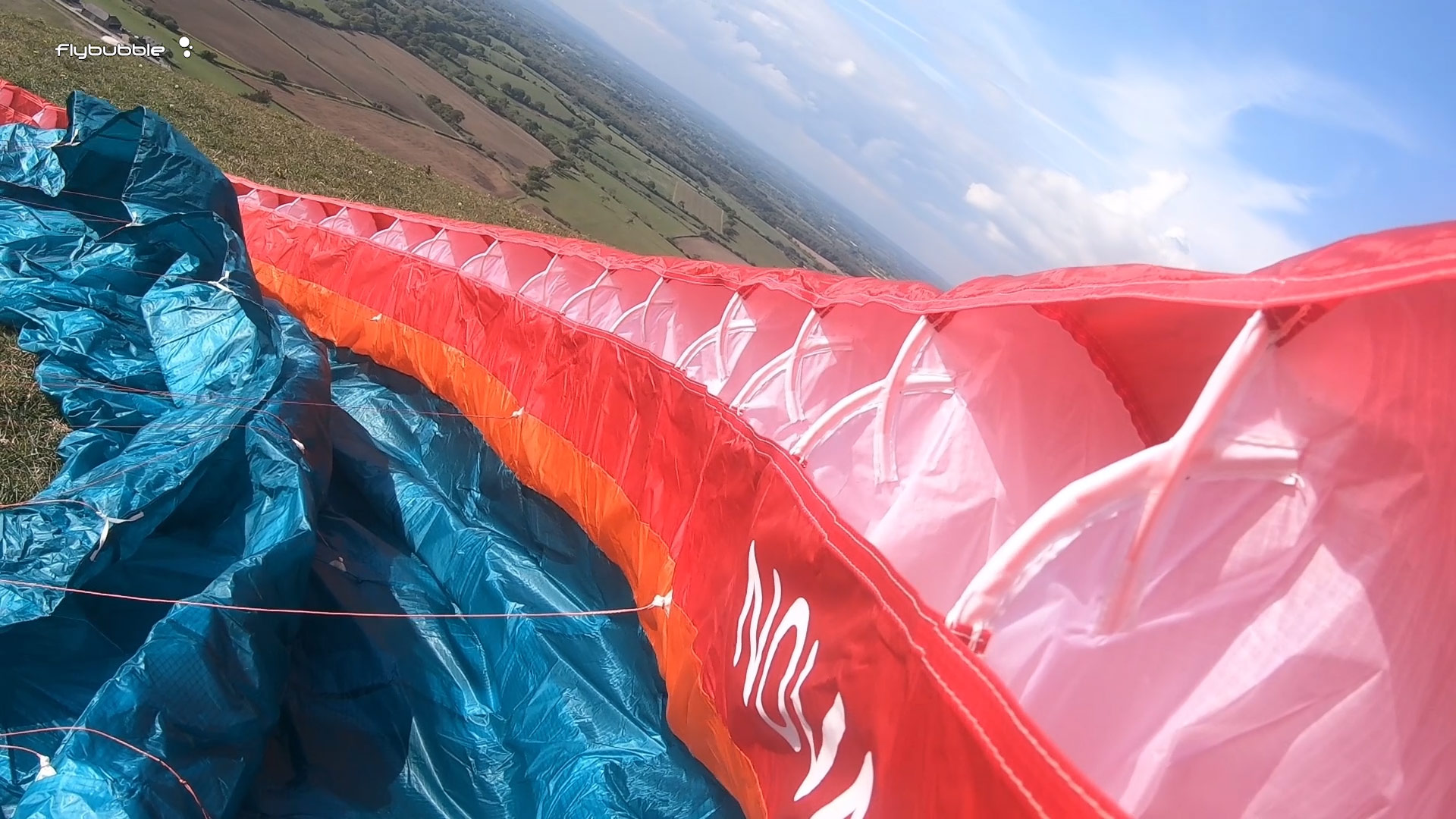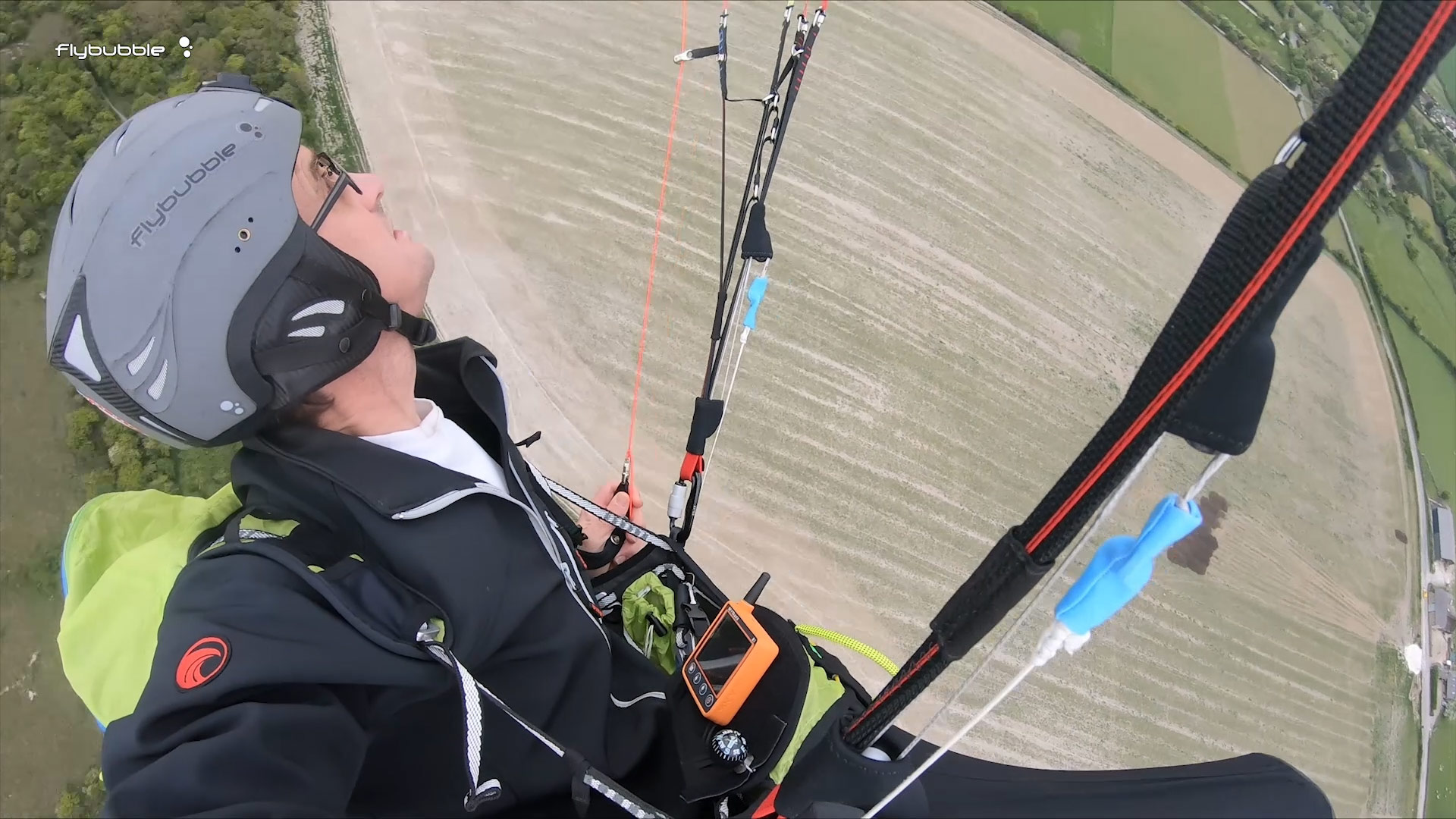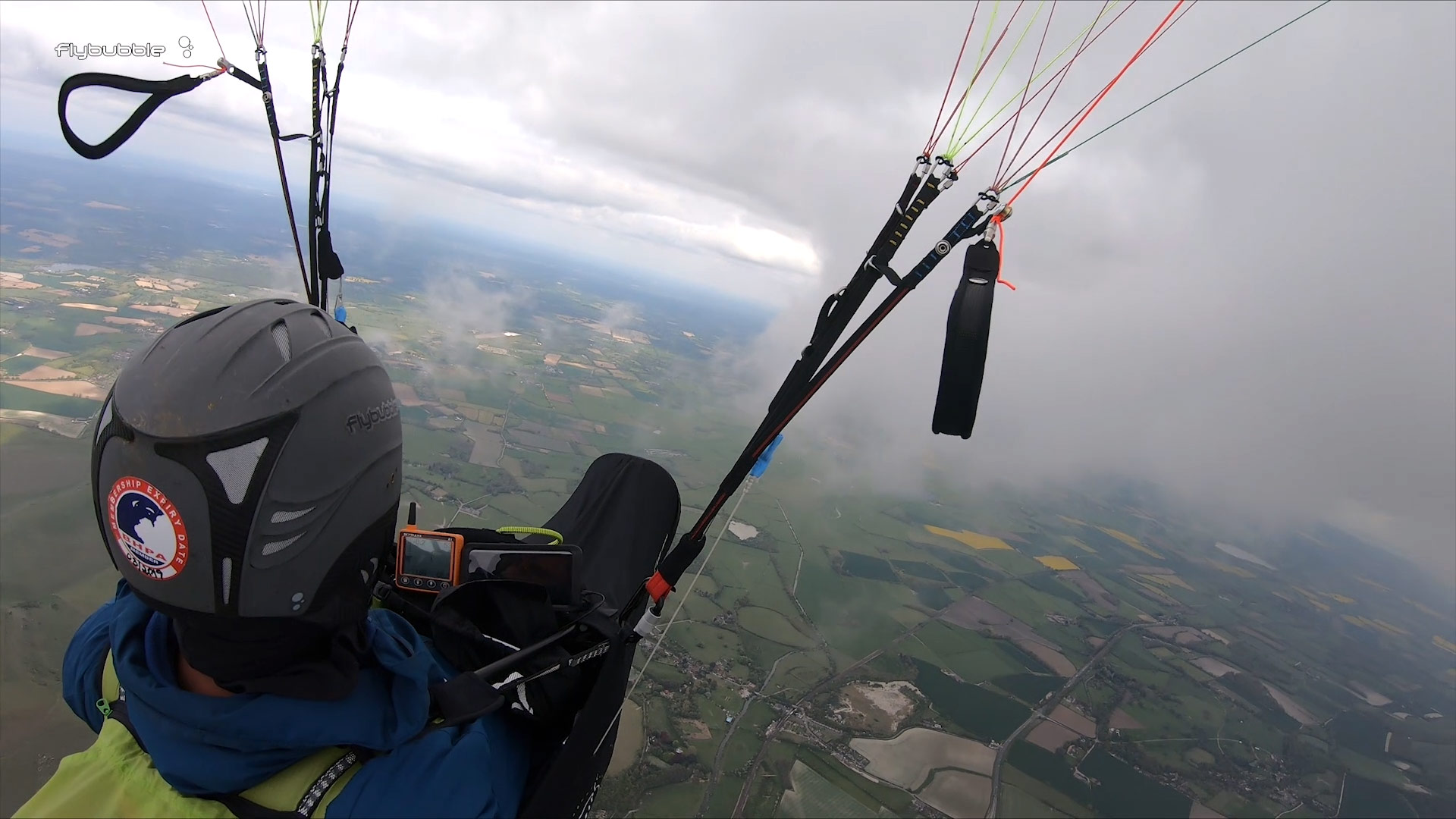
It’s only two years since I reviewed the Mentor 5 (and the Mentor 4, 2 years before that). NOVA have a regular release schedule and are bang on target with this update, ‘A sports intermediate for cross-country and fun flying’. Has the reliable stalwart of the ‘high B’ class changed much?
Nova MENTOR 6: Construction

Wide cell openings with thick ‘no fuss’ flexible plastic wires and a pronounced cross-over produce a leading edge that gulps at the air and fills easily during launch. One of the lowest aspect ratios in the class means you can expect an easy-to-manage sail with simple handling. New zigzag shaping and minirib detailing makes it look cleaner than predecessors, particularly along the trailing edge during braking.
It has 3 As, 3 Bs, 3 Cs and a stabilo line on each side, which is fairly standard and slightly more base lines than some ‘performance optimised’ wings in the class. A new row of split B’s adds short support lines near the canopy to improve weight distribution. The risers are functional narrow black webbing with maillons and O-rings. The wide brake loops (secured on poppers) are comfortable, but their sponginess further dampens the brake responses, so I preferred using a half-wrap (or gripping near the swivel) to get more direct contact with the brake lines.
Nova MENTOR 6: Launching

The Mentor 6 has steady, easy, unreactive launching, with a good tolerance for pulling up badly, skew, and giving you lots of time to put in mistimed corrections. It pauses overhead, and can be allowed to search ahead of the pilot without collapsing, again very helpful for newcomers to the class on steeper launches.
Nova MENTOR 6: In the air

The Mentor 6 has a high amount of pitch dampening and a detuned, undemanding feeling in the air. It takes a bit of time to respond to brake input, and shows little interest in weightshift. You can ‘crank it around’ with deep brake input to hold onto tight thermal cores but the wing tends to roll and lose a bit of height while doing so.
It offers low feedback about the air currents, so you have to use logic rather than feel to choose where to fly to and what to do with the beeps on your vario.
The outer tip likes to tuck during quick direction changes, so you are required to keep a touch of outside brake on, further reducing the agility.
The advantage of the slower responses is that if you make mistakes with your input or encounter unexpected turbulence, there is very little energy to manage. It isn’t the kind of wing that will surprise you with sudden moves.
Nova MENTOR 6: Safety

The Mentor 6 is a particularly calm wing, and would suit prolonged flights in rough conditions, where a wing with higher feedback would become tiring to manage. The Mentor 6 reduces the workload, absorbs a lot of the energy of the air, and transmits little to the pilot.
Big ears are easy to engage, flap around a bit, but are stable and self-inflate upon release. It's roll stable, and pitch stable. Most aspects of this wing point towards a ‘low B’ but when I tested large collapses I found that it generated some energy in the recovery dive and turn which makes it more suited to experienced pilots and match the ‘high B / XC Class’ category.
The stall point and spin point are more accessible than previous Mentors, but well within acceptable range.
Nova MENTOR 6: Performance

When on glide, it glides straight and isn’t disturbed by much. You can use your phone, take photographs, and conserve your energy on transitions. As with previous Mentors, this is where the performance comes from – the lack of pilot intervention required, meaning that many pilots will get the same good glide out of the wing. It doesn’t require any special skills to maximise the performance.
Nova says: ‘The MENTOR 6 (EN B) will help you to reach your goals faster - especially when accelerated’. I am not sure that pilots in this class spend much time on the accelerator, but if they did they would find this the most comforting wing to fly on bar. The speedbrake risers can help you control the pitch, but I found them largely unnecessary. You can cruise along on full bar, with no worries.
As with any aerofoil with a large camber and low aspect ratio, there is a loss of gliding performance at speed, but the wing does not feel ‘critical’ in any way, because it is very steady in pitch.
Nova MENTOR 6: Who is it for?

The Mentor 6 is very tolerant of various inputs, and is best suited to first timers in the XC class. It makes a nice progression up from the Nova ION and similar wings.
It is calm, steady, and simple to fly. It doesn’t require fast reactions, so perhaps if you’re getting on in years, it will be a good match as it gives you time to make the inputs. For enthusiastic newcomers, the Mentor 6 helps you get away with some things you maybe shouldn’t be doing.
If you want feedback, life and energy, this is not the wing for you, but if you are going into ‘big air’ for the first time, taking on serious mountain flying like the Alps or Rockies, or feel intimidated by steep launches and a lack of current airtime, this wing will help you get it right while you concentrate on enjoying the view.
Find out more about the Nova MENTOR 6
Nova MENTOR 6: Video review
Join Greg for some seabreeze convergence flying as he tests the Nova MENTOR 6
As always, when considering a new wing it’s worth taking the time to discuss your experience, aspirations and full equipment to be sure you get the right match. That is our unique advantage. Along with the extensive demo fleet we keep in stock and our broad knowledge of current designs, we can take your current gear in part exchange. If you’re getting a new wing, consider our MATCH service.
Brought to you by Flybubble
Like what we do? The best way to thank and support us is to buy gear from us and recommend us to others. Review our service on Trustpilot and our products on Flybubble Shop. You can also subscribe to Flybubble Patreon. Thank you!

